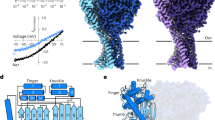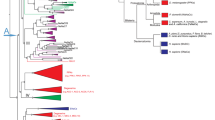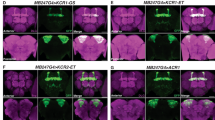Abstract
The vomeronasal organ (VNO) is essential for intraspecies communication in many terrestrial vertebrates. The ionic mechanisms of VNO activation remain unclear. We found that the calcium-activated potassium channel SK3 and the G protein–activated potassium channel GIRK are part of an independent pathway for VNO activation. In slice preparations, the potassium channels attenuated inward currents carried by TRPC2 and calcium-activated chloride channels (CACCs). In intact tissue preparations, paradoxically, the potassium channels enhanced urine-evoked inward currents. This discrepancy resulted from the loss of a high concentration of lumenal potassium, which enabled the influx of potassium ions to depolarize the VNO neurons in vivo. Both Sk3 (also known as Kcnn3) and Girk1 (also known as Kcnj3) homozygous null mice showed deficits in mating and aggressive behaviors, and the deficiencies in Sk3−/− mice were exacerbated by Trpc2 knockout. Our results suggest that VNO activation is mediated by TRPC2, CACCs and two potassium channels, all of which contributed to the in vivo depolarization of VNO neurons.
This is a preview of subscription content, access via your institution
Access options
Subscribe to this journal
Receive 12 print issues and online access
$209.00 per year
only $17.42 per issue
Buy this article
- Purchase on Springer Link
- Instant access to full article PDF
Prices may be subject to local taxes which are calculated during checkout








Similar content being viewed by others
References
Halpern, M. The organization and function of the vomeronasal system. Annu. Rev. Neurosci. 10, 325–362 (1987).
Tirindelli, R., Dibattista, M., Pifferi, S. & Menini, A. From pheromones to behavior. Physiol. Rev. 89, 921–956 (2009).
Meredith, M. Chronic recording of vomeronasal pump activation in awake behaving hamsters. Physiol. Behav. 56, 345–354 (1994).
Dulac, C. & Axel, R. A novel family of genes encoding putative pheromone receptors in mammals. Cell 83, 195–206 (1995).
Herrada, G. & Dulac, C. A novel family of putative pheromone receptors in mammals with a topographically organized and sexually dimorphic distribution. Cell 90, 763–773 (1997).
Matsunami, H. & Buck, L.B. A multigene family encoding a diverse array of putative pheromone receptors in mammals. Cell 90, 775–784 (1997).
Pantages, E. & Dulac, C. A novel family of candidate pheromone receptors in mammals. Neuron 28, 835–845 (2000).
Ryba, N.J. & Tirindelli, R. A new multigene family of putative pheromone receptors. Neuron 19, 371–379 (1997).
Rivière, S., Challet, L., Fluegge, D., Spehr, M. & Rodriguez, I. Formyl peptide receptor–like proteins are a novel family of vomeronasal chemosensors. Nature 459, 574–577 (2009).
Liberles, S.D. et al. Formyl peptide receptors are candidate chemosensory receptors in the vomeronasal organ. Proc. Natl. Acad. Sci. USA 106, 9842–9847 (2009).
Inamura, K., Kashiwayanagi, M. & Kurihara, K. Inositol-1,4,5-trisphosphate induces responses in receptor neurons in rat vomeronasal sensory slices. Chem. Senses 22, 93–103 (1997).
Sasaki, K., Okamoto, K., Inamura, K., Tokumitsu, Y. & Kashiwayanagi, M. Inositol-1,4,5-trisphosphate accumulation induced by urinary pheromones in female rat vomeronasal epithelium. Brain Res. 823, 161–168 (1999).
Spehr, M., Hatt, H. & Wetzel, C.H. Arachidonic acid plays a role in rat vomeronasal signal transduction. J. Neurosci. 22, 8429–8437 (2002).
Kroner, C., Breer, H., Singer, A.G. & O'Connell, R.J. Pheromone-induced second messenger signaling in the hamster vomeronasal organ. Neuroreport 7, 2989–2992 (1996).
Liman, E.R., Corey, D.P. & Dulac, C. TRP2: a candidate transduction channel for mammalian pheromone sensory signaling. Proc. Natl. Acad. Sci. USA 96, 5791–5796 (1999).
Lucas, P., Ukhanov, K., Leinders-Zufall, T. & Zufall, F. A diacylglycerol-gated cation channel in vomeronasal neuron dendrites is impaired in TRPC2 mutant mice: mechanism of pheromone transduction. Neuron 40, 551–561 (2003).
Vannier, B. et al. Mouse trp2, the homologue of the human trpc2 pseudogene, encodes mTrp2, a store depletion-activated capacitative Ca2+ entry channel. Proc. Natl. Acad. Sci. USA 96, 2060–2064 (1999).
Stowers, L., Holy, T.E., Meister, M., Dulac, C. & Koentges, G. Loss of sex discrimination and male-male aggression in mice deficient for TRP2. Science 295, 1493–1500 (2002).
Leypold, B.G. et al. Altered sexual and social behaviors in trp2 mutant mice. Proc. Natl. Acad. Sci. USA 99, 6376–6381 (2002).
Kimchi, T., Xu, J. & Dulac, C. A functional circuit underlying male sexual behaviour in the female mouse brain. Nature 448, 1009–1014 (2007).
Liman, E.R. Regulation by voltage and adenine nucleotides of a Ca2+-activated cation channel from hamster vomeronasal sensory neurons. J. Physiol. (Lond.) 548, 777–787 (2003).
Spehr, J. et al. Ca2+-calmodulin feedback mediates sensory adaptation and inhibits pheromone-sensitive ion channels in the vomeronasal organ. J. Neurosci. 29, 2125–2135 (2009).
Yang, C. & Delay, R.J. Calcium-activated chloride current amplifies the response to urine in mouse vomeronasal sensory neurons. J. Gen. Physiol. 135, 3–13 (2010).
Kim, S., Ma, L. & Yu, C.R. Requirement of calcium-activated chloride channels in the activation of mouse vomeronasal neurons. Nat. Commun. 2, 365 (2011).
Hagendorf, S., Fluegge, D., Engelhardt, C. & Spehr, M. Homeostatic control of sensory output in basal vomeronasal neurons: activity-dependent expression of ether-a-go-go-related gene potassium channels. J. Neurosci. 29, 206–221 (2009).
Inamura, K., Kashiwayanagi, M. & Kurihara, K. Blockage of urinary responses by inhibitors for IP3-mediated pathway in rat vomeronasal sensory neurons. Neurosci. Lett. 233, 129–132 (1997).
Bond, C.T. et al. Respiration and parturition affected by conditional overexpression of the Ca2+-activated K+ channel subunit SK3. Science 289, 1942–1946 (2000).
Krapivinsky, G. et al. The G protein–gated atrial K+ channel IKACh is a heteromultimer of two inwardly rectifying K+-channel proteins. Nature 374, 135–141 (1995).
Hedin, K.E., Lim, N.F. & Clapham, D.E. Cloning of a Xenopus laevis inwardly rectifying K+ channel subunit that permits GIRK1 expression of IKACh currents in oocytes. Neuron 16, 423–429 (1996).
Bettahi, I., Marker, C.L., Roman, M.I. & Wickman, K. Contribution of the Kir3.1 subunit to the muscarinic-gated atrial potassium channel IKACh. J. Biol. Chem. 277, 48282–48288 (2002).
Barfod, E.T., Moore, A.L. & Lidofsky, S.D. Cloning and functional expression of a liver isoform of the small conductance Ca2+-activated K+ channel SK3. Am. J. Physiol. Cell Physiol. 280, C836–C842 (2001).
Nikolov, E.N. & Ivanova-Nikolova, T.T. Functional characterization of a small conductance GIRK channel in rat atrial cells. Biophys. J. 87, 3122–3136 (2004).
Zhang, P., Yang, C. & Delay, R.J. Urine stimulation activates BK channels in mouse vomeronasal neurons. J. Neurophysiol. 100, 1824–1834 (2008).
Ukhanov, K., Leinders-Zufall, T. & Zufall, F. Patch-clamp analysis of gene-targeted vomeronasal neurons expressing a defined V1r or V2r receptor: ionic mechanisms underlying persistent firing. J. Neurophysiol. 98, 2357–2369 (2007).
Wekesa, K.S. & Anholt, R.R. Pheromone regulated production of inositol-(1, 4, 5)-trisphosphate in the mammalian vomeronasal organ. Endocrinology 138, 3497–3504 (1997).
Zhang, P., Yang, C. & Delay, R.J. Odors activate dual pathways, a TRPC2 and a AA-dependent pathway, in mouse vomeronasal neurons. Am. J. Physiol. Cell Physiol. 298, C1253–C1264 (2010).
Labra, A., Brann, J.H. & Fadool, D.A. Heterogeneity of voltage- and chemosignal-activated response profiles in vomeronasal sensory neurons. J. Neurophysiol. 94, 2535–2548 (2005).
Fadool, D.A., Wachowiak, M. & Brann, J.H. Patch-clamp analysis of voltage-activated and chemically activated currents in the vomeronasal organ of Sternotherus odoratus (stinkpot/musk turtle). J. Exp. Biol. 204, 4199–4212 (2001).
Moss, R.L. et al. Urine-derived compound evokes membrane responses in mouse vomeronasal receptor neurons. J. Neurophysiol. 77, 2856–2862 (1997).
Moss, R.L. et al. Electrophysiological and biochemical responses of mouse vomeronasal receptor cells to urine-derived compounds: possible mechanism of action. Chem. Senses 23, 483–489 (1998).
Holy, T.E., Dulac, C. & Meister, M. Responses of vomeronasal neurons to natural stimuli. Science 289, 1569–1572 (2000).
Imai, T. & Sakano, H. Odorant receptor–mediated signaling in the mouse. Curr. Opin. Neurobiol. 18, 251–260 (2008).
Norlin, E.M., Gussing, F. & Berghard, A. Vomeronasal phenotype and behavioral alterations in G alpha i2 mutant mice. Curr. Biol. 13, 1214–1219 (2003).
Chamero, P. et al. G protein G(alpha)o is essential for vomeronasal function and aggressive behavior in mice. Proc. Natl. Acad. Sci. USA 108, 12898–12903 (2011).
Hasen, N.S. & Gammie, S.C. Trpc2 gene impacts on maternal aggression, accessory olfactory bulb anatomy and brain activity. Genes Brain Behav. 8, 639–649 (2009).
Kelliher, K.R., Spehr, M., Li, X.H., Zufall, F. & Leinders-Zufall, T. Pheromonal recognition memory induced by TRPC2-independent vomeronasal sensing. Eur. J. Neurosci. 23, 3385–3390 (2006).
He, J. et al. Distinct signals conveyed by pheromone concentrations to the mouse vomeronasal organ. J. Neurosci. 30, 7473–7483 (2010).
Leinders-Zufall, T. et al. Ultrasensitive pheromone detection by mammalian vomeronasal neurons. Nature 405, 792–796 (2000).
Liman, E.R. & Corey, D.P. Electrophysiological characterization of chemosensory neurons from the mouse vomeronasal organ. J. Neurosci. 16, 4625–4637 (1996).
Acknowledgements
We are truly grateful for the continuing support and guidance from R. Axel, from whose laboratory this work originated. We appreciate the generosity of K. Wickman (University of Minnesota) for providing the Girk1−/− mice and E. Liman (University of Southern California) for providing the TRPC2 antibodies. We thank A. Moran, S. Klinefelter and the Lab Animal Services at the Stowers Institute for technical assistance. We thank S. Haga-Yamanaka for critical comments on the paper, H. Li and L. Chandrasekaran for statistical consultation, and C. McLaughlin for editorial assistance. This work is supported by funding from the Stowers Institute and the US National Institutes of Health (National Institute on Deafness and Other Communication Disorders 008003) to C.R.Y. The content of this study is solely the responsibility of the authors and does not necessarily represent the official views of the National Institute on Deafness and Other Communication Disorders or the US National Institutes of Health.
Author information
Authors and Affiliations
Contributions
S.K. and C.R.Y. performed the electrophysiology experiments and data analyses. L.M. and C.R.Y. performed the histology experiments. L.M. prepared the mice used in the studies. K.L.J., M.M.K. and C.R.Y. performed behavior analyses. C.T.B. and J.P.A. contributed critical reagent. C.R.Y. wrote the manuscript with the input from S.K., L.M., J.P.A. and K.L.J.
Corresponding author
Ethics declarations
Competing interests
The authors declare no competing financial interests.
Supplementary information
Supplementary Text and Figures
Supplementary Figures 1–5 and Supplementary Table 1 (PDF 5294 kb)
Rights and permissions
About this article
Cite this article
Kim, S., Ma, L., Jensen, K. et al. Paradoxical contribution of SK3 and GIRK channels to the activation of mouse vomeronasal organ. Nat Neurosci 15, 1236–1244 (2012). https://doi.org/10.1038/nn.3173
Received:
Accepted:
Published:
Issue Date:
DOI: https://doi.org/10.1038/nn.3173
This article is cited by
-
Is the Loss of Trpc2 Gene Function a Real Working Hypothesis for the Emergence of Same-Sex Sexual Behavior in Old World Primates?
Archives of Sexual Behavior (2021)
-
Loss of Glis3 causes dysregulation of retrotransposon silencing and germ cell demise in fetal mouse testis
Scientific Reports (2018)
-
Type 3 inositol 1,4,5-trisphosphate receptor is dispensable for sensory activation of the mammalian vomeronasal organ
Scientific Reports (2017)
-
Intracellular chloride concentration of the mouse vomeronasal neuron
BMC Neuroscience (2015)
-
A wide range of pheromone-stimulated sexual and reproductive behaviors in female mice depend on G protein Gαo
BMC Biology (2014)



